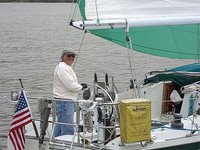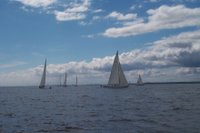Here in the Northeast U.S. summer is delimited by Memorial Day and Labor Day. Between those two dates, slips are hard come by, moorings are iffy, and the Long Island Sound is thick with boats on weekends. Before or after, one has most of all facilities to themselves.
This Labor Day weekend started with the remains of Ernesto which left a number of moored boats on lee shores. Saturday was consistantly rainy with winds out of the east. On the Sound, east and west winds are absolutely the worst. There is nearly 100 miles of fetch and the Sound shoals at either end. It can get very nasty with waves in the 10-15 foot range but very close together. I've been in 10-12 foot waves that were little more than 60 feet crest to crest. That's short, steep, and very uncomfortable.
Fortunately for my clubmates and I, City Island Yacht Club is on the west side of City Island, so although there were steady east winds at 35 knots gusting to 50 (or so I've heard), our boats were well protected. The club had its Labor Day cookout, but I spent the day creatively napping.
Sunday, however was a different story. I got to the boat around 8 am. when it was cloudy and threating looking. But as someone's mother said, there was more than enough blue in the sky to make a pair of pants. Also, a nice breeze was filling in from the southwest.
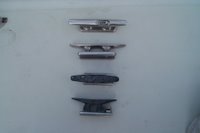
I took a few minutes to install the lovely toerail cleats I purchased (pictures show why - new on top), and then started calling my friends to see if they could come out and play. My first call to Herb went something like this:
"Hi Herb, you coming sailing today? Let's go to Oyster Bay!"
"Uh, I don't know it's looking kinda gloomy here."
"Nah, it's sunny with white puffy clouds - it's heading your way."
"I don't see it - it looks like, uh, wait a minute! It's getting sunny! We'll see you there!"
Essentially the same conversation with Bob and Carol, and Jack. So a plan is afoot. My guest couldn't make it, so I had enough food for an army. (There is nothing wrong with keeping a well stocked boat. Besides, my friends all expect it from me.)
The wind was delightful as I sailed off the mooring around the southern tip of City Island, then up between City Island and Hart Island. The morning had become quite comfortable so I took the opportunity to go shirtless for a last time this year, I supposed.
I sailed through the channel between David's Island and Hart Island out towards Execution Rock Light. The wind was building out of the south southwest, so it was nearly perfect for a broad reach. And so I went. A lovely day, a lovely sail.
About three hours later I arrived at the entrance to the Cold Spring/Oyster Bay harbors. Since there was no rush at all, I sailed almost to the agreed upon anchorage. I know I could anchor under sail, but running the engine for a bit gives me hot water for later. How hedonistic...
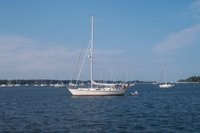
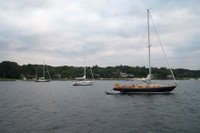
Not too long thereafter in sailed Herb & Gina on
Goldeneye (a Passport 40), followed by Jack on
Barefoot (an Olsen 38), and Bob & Carol on
Spirit (an Ericson 35). Since we planned to all leave at different times, we all anchored seperately. Normally, I'll raft up with Jack or he with me.

Anyway Herb blew up his dinghy ( I didn't bring my kyack) and came and got me with all my food and wine and so forth to instigate a party on Goldeneye. So as we waited for the others, we figured sun over the yardarm and all, it was time for wine, cheese, crackers, and anything else we could put out.
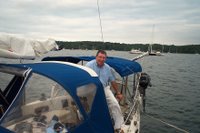
Jack showed up, followed by Bob & Carol who had gone to look for the mooring they'd be using for the night after the party. So they rafted to Goldeneye and I took the dinghy to pick up Jack, and all were there for the cocktail hour(s).
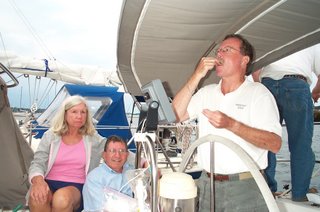

The official hors d'oeuvre of Inertia is hot soprasotta, brie cheese and Triskets. Although a new one is being added for variety: smoked oysters with cream cheese on Triskets. Triskets figure prominently in my boating because even if damp still retain the necessary structural integrity to contain the toppings. Your soda crackers and so forth become too mushy. But I digress.
The night was cool and as it progressed it got cloudy, almost looking as if it were going to rain. But it didn't.
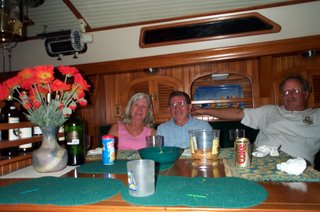


Dinner, eventually, was barbequed chicken and salad and other sides - down in Goldeneye out of the cool evening. Very toasty, very comfortable, and very good. It must be the fresh air!
Eventually, even veteran partiers must give in to Morpheus' gentle prodding, and Bob & Carol dropped Jack and I off on our boats on their way to the mooring. After checking the anchor, taking a lukewarm shower in the cockpit and reading for a bit I went to sleep.

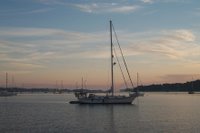
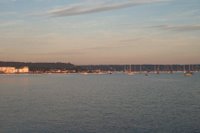
Because Laura was having a barbeque on Monday, I had to get up early to get the tide out of Oyster Bay at least and to sail back to City Island. So I got up around 6 am and made my coffee, and because of the lack of wind, started the engine, weighed anchor and started my journey back. As usual I was mildly irritated that I'd have to motor home against the tide, but lo and behold, as I got to the harbor entrance, the wind came up out of the west (feh! Nothing but tacking back and forth!).
Still, I raised the sails and off I went. The problem of going west against the tide and into a west wind is that huge tacks across the sound take lots of time but gain very little towards the goal so when the wind died about two hours later, I decided to motor the rest of the way (still over an hour away).
The surest way to get a fair wind is to lower and cover the sails. I guarantee it. After a half hour of motoring the wind veered to the northwest, a perfect point for sailing back to the club. It also increased to 15 knots or so, so being lazy, I unfurled the jib, and shutdown the motor. Woohoo! Perfect! The Best! Sunny, puffy white clouds, boat heeled in a most nautical way, speeding along with the champagne bubbles sound, breeze in what is left of my hair and flat seas.
What a perfect moment. These moments (ok, hours) are what make all the aggravation of keeping a boat worthwhile. More than worthwhile.
Eventually, I got back to City Island, cleaned up and put away the boat and headed off to Laura's party. Some pictures - all people you may or may not know, but all having a great time! The food was excellent, as was the company.




Laura's only complaint was that we should have done the Vineyard Race - from Stamford, CT. to Buzzards Bay Light and back. It started on Saturday, and all but 4 boats dropped out. She was pissed because we could have won! Yes, well, that's true. But let's see, a day racing in storm conditions or two days gently sailing about and partying? Hmmm, which shall I choose?
You know which one.
Well, Monday ended when I scooted home and toddled off to bed. The weather was so perfect for sleeping I almost didn't get up in time for work. Yech!
Still, there are a lot more weekends to be had this year! So I hope I'll see you on the water for a few of them, anyway!

 It finally happened. Inertia was finally picked up and shipped to her new owner in Wisconsin. It took all day to pack her up - removing the boom and vang, getting all her equipment down and packed, and finally loading on the trailer took another day.
It finally happened. Inertia was finally picked up and shipped to her new owner in Wisconsin. It took all day to pack her up - removing the boom and vang, getting all her equipment down and packed, and finally loading on the trailer took another day. number of boat shippers, and all of them will promise the world. Delivery, however, seems to be a problem. Joe, Inertia's new owner, had to cancel a contract with one shipper and get another because the first was a no-show. So, she shipped out a couple of weeks late.
number of boat shippers, and all of them will promise the world. Delivery, however, seems to be a problem. Joe, Inertia's new owner, had to cancel a contract with one shipper and get another because the first was a no-show. So, she shipped out a couple of weeks late. The hardest part is dismantling the mast. Our yard charges $350.00 to do it. They remove all the rigging and label it. You can also wrap the
The hardest part is dismantling the mast. Our yard charges $350.00 to do it. They remove all the rigging and label it. You can also wrap the  mast with bubble wrap, lay the rigging against that, and wrap again. I pulled all the halyards all the way up to the masthead and coiled them at the bottom of the mast. I also removed the spreaders and wrapped them, placing them in the quarter berth.
mast with bubble wrap, lay the rigging against that, and wrap again. I pulled all the halyards all the way up to the masthead and coiled them at the bottom of the mast. I also removed the spreaders and wrapped them, placing them in the quarter berth. On shipping day, everyone was unsure if the truck would make it, but it did, albeit an hour late. Stan, the driver, was great! Full of sailing stories, very helpful and knowledgeable. Working with him made the day go quickly. My friend Leigh helped as well because, foolishly, I left my tools at home so had to give him an emergency call because I needed to remove the sissybars in front of the mast. Apparently, there is a 13' 6" height limit for non-permitted over-the-road travel. Inertia without the sissybar came out to 13' 4". Good as gold!
On shipping day, everyone was unsure if the truck would make it, but it did, albeit an hour late. Stan, the driver, was great! Full of sailing stories, very helpful and knowledgeable. Working with him made the day go quickly. My friend Leigh helped as well because, foolishly, I left my tools at home so had to give him an emergency call because I needed to remove the sissybars in front of the mast. Apparently, there is a 13' 6" height limit for non-permitted over-the-road travel. Inertia without the sissybar came out to 13' 4". Good as gold! Getting her ready was bittersweet, as I'm sure you can imagine. She looked as good as any of the new boats coming in on trailers. Well, I think Joe and Kathy and their children will enjoy her for a lot of years to come.
Getting her ready was bittersweet, as I'm sure you can imagine. She looked as good as any of the new boats coming in on trailers. Well, I think Joe and Kathy and their children will enjoy her for a lot of years to come.





















